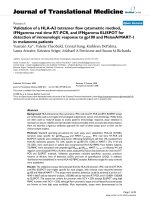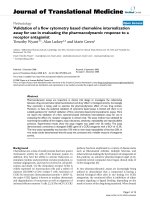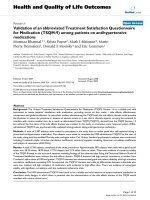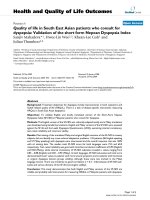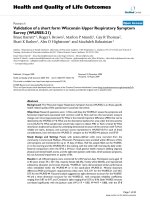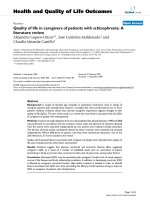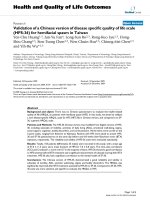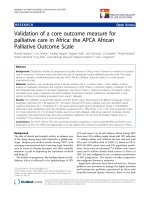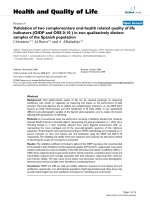báo cáo hóa học:" Validation of the Spanish version of the Chronic Pain Acceptance Questionnaire (CPAQ) for the assessment of acceptance in fibromyalgia" pot
Bạn đang xem bản rút gọn của tài liệu. Xem và tải ngay bản đầy đủ của tài liệu tại đây (686.13 KB, 10 trang )
Rodero et al. Health and Quality of Life Outcomes 2010, 8:37
/>Open Access
RESEARCH
BioMed Central
© 2010 Rodero et al; licensee BioMed Central Ltd. This is an Open Access article distributed under the terms of the Creative Commons
Attribution License ( which permits unrestricted use, distribution, and reproduction in
any medium, provided the original work is properly cited.
Research
Validation of the Spanish version of the Chronic
Pain Acceptance Questionnaire (CPAQ) for the
assessment of acceptance in fibromyalgia
Baltasar Rodero
1
, Javier García-Campayo*
2,6
, Benigno Casanueva
3
, Yolanda Lopez del Hoyo
4
, Antoni Serrano-Blanco
5
and Juan V Luciano
5
Abstract
Background: The aim of this study was to validate a Spanish version of the Chronic Pain Acceptance Questionnaire
(CPAQ). Pain acceptance is the process of giving up the struggle with pain and learning to live a worthwhile life despite
it. The Chronic Pain Acceptance Questionnaire (CPAQ) is the questionnaire most often used to measure pain
acceptance in chronic pain populations.
Methods: A total of 205 Spanish patients diagnosed with fibromyalgia syndrome who attended our pain clinic were
asked to complete a battery of psychometric instruments: the Pain Visual Analogue Scale (PVAS) for pain intensity, the
Hospital Anxiety and Depression Scale (HADS), the Medical Outcome Study Short Form 36 (SF-36), the Pain
Catastrophising Scale (PCS) and the Fibromyalgia Impact Questionnaire (FIQ).
Results: Analysis of results showed that the Spanish CPAQ had good test-retest reliability (intraclass correlation
coefficient 0.83) and internal consistency reliability (Cronbach's α: 0.83). The Spanish CPAQ score significantly correlated
with pain intensity, anxiety, depression, pain catastrophising, health status and physical and psychosocial disability. The
Scree plot and a Principal Components Factor analysis confirmed the same two-factor construct as the original English
CPAQ.
Conclusion: The Spanish CPAQ is a reliable clinical assessment tool with valid construct validity for the acceptance
measurement among a sample of Spanish fibromyalgia patients. This study will make it easier to assess pain
acceptance in Spanish populations with fibromyalgia.
Background
Fibromyalgia is a chronic musculoskeletal pain disorder
of unknown aetiology, characterised by widespread pain
and muscle tenderness and often accompanied by fatigue,
sleep disturbance and depressed mood [1,2]. The progno-
sis for symptomatic recovery is generally poor, and the
estimation for lifetime prevalence is approximately 2% in
community samples [3]. The syndrome's pathology is not
well understood and, to date, no treatment has proven
effective in fully alleviating its symptoms.
In the last decade, "acceptance" has emerged as a valu-
able construct for contextual or third wave psychothera-
pies. Although sometimes misinterpreted as surrender
[4], the real concept is far from this idea. Acceptance of
chronic pain involves the individual reducing unsuccess-
ful attempts to avoid or control pain and focusing instead
on participation in valued activities and the pursuit of
personally relevant goals [5].
Hayes described, for the first time, a general measure of
acceptance and experiential avoidance, the Acceptance
and Action Questionnaire [6,7]. The CPAQ was devel-
oped by Geiser [8] as an adaptation of this assessment for
patients with chronic pain. Subsequent analyses carried
* Correspondence:
2
Department of Psychiatry, Miguel Servet University Hospital, Instituto
Aragonés de Ciencias de la Salud, Spain
Full list of author information is available at the end of the article
Rodero et al. Health and Quality of Life Outcomes 2010, 8:37
/>Page 2 of 10
out by McCracken [5,9,10] critically evaluated the con-
tent and factor structure, improving the questionnaire.
Factor analysis of the main tool for measuring accep-
tance, the Chronic Pain Acceptance Questionnaire
(CPAQ), initially reveals 34 items and four components,
which are as follows: activity engagement; pain willing-
ness; thought control and chronicity. Based on evaluation
of the psychometric properties of these four subscales,
however, McCracken et al. [5] reduced the CPAQ to only
20 items and two subscales (activity engagement and pain
willingness). A recent confirmatory factor analysis has
provided further support for these 20 items and two-fac-
tor construct of the CPAQ [11].
The Activity Engagement subscale consists of eleven
items and gauges the extent to which a person follows
their activities in a normal way regardless of their experi-
ence of pain. The Pain Willingness subscale has nine
items and measures how much a patient believes that
avoiding or controlling pain are strategies that work for
him. A total score is reached by combining both sub-
scales. Previous research studies [5,9,12,13] show that
acceptance of pain and willingness to act in its presence
are associated with reports of lower pain intensity, less
pain-related anxiety and avoidance, less depression, less
physical and psychosocial disability, more daily uptime
and better work status. Contrary to what is expected,
pain acceptance does not correlate with pain intensity.
The reason for this lack of correlation is that acceptance
can be considered as similar to a personality trait, with a
normal distribution in the population, and is independent
from pain level. Finally, acceptance of pain predicts better
adjustment on measures of patient functioning than per-
ceived pain intensity does, which continues to be true
even when pain intensity is factored out (see [14,15] for
review papers on this subject).
These results imply the potential of an improved out-
come for acceptance-based clinical methods for chronic
pain management. The CPAQ has already been validated
in German [16] and Chinese [17]; however, currently, a
measure of acceptance of pain is not available in Spanish.
Therefore, we translated the revised version of the CPAQ
into Spanish and tested its reliability and validity in Span-
ish patients suffering from fibromyalgia.
Materials and methods
Participants
Sample size was calculated according to the recom-
mended 10:1 ratio of the number of subjects to the num-
ber of test items [18]. The final study sample consisted of
205 patients attending the Pain Clinic (Santander, Spain)
and Fibromyalgia Unit (Hospital Miguel Servet, Zara-
goza) during the year 2009. To be included in the study,
patients had to fulfil the American College of Rheumatol-
ogy (ACR) criteria for primary fibromyalgia
1
, which was
diagnosed by a Spanish National Health Service rheuma-
tologist. The only exclusion criterion was a medical or
psychiatric disorder that impeded the patient's ability to
correctly answer the questionnaire. The study question-
naires and protocol were approved by the Ethical Com-
mittee of the regional health authority, and patients
signed a consent form attesting to their willingness to
participate in the study.
After consenting to the study, recruited patients were
given a battery of questionnaires for completion. All
patients completed these instruments on the day of the
visit. These included a pain form for demographic and
pain-related variables, including the translated Spanish
version of the CPAQ to be validated, a Pain Visual Ana-
logue Scale (PVAS) for pain intensity, and the validated
Spanish versions of the Hospital Anxiety and Depression
Scale (HADS), the Short Form 36 (SF 36), the Pain Catas-
trophising Score (PCS) and the Fibromyalgia Impact
Questionnaire (FIQ).
Translation of the CPAQ
Two researchers, who were aware of the objectives of the
CPAQ, did the first translation into Spanish. Each
researcher translated the questionnaire separately. Subse-
quently, two native English teachers who had no knowl-
edge regarding the instrument carried out back-
translations. Finally the two English versions were judged
equivalent by a third native English teacher, [5]. Any dif-
ferences between the translators were resolved by mutual
agreement. Both translators and authors were present at
the agreement. The authors read and write technical Eng-
lish and know the psychological construct to be assessed
with the questionnaire well. We have followed the usual
guidelines for cross-cultural adaptations [19]. The origi-
nal authors accepted the questionnaire to be translated.
They were sent the final version of the paper, and they
agree with the results.
Measurement tools
1 Pain Visual Analogue Scale (PVAS)
The PVAS consists of a 10 cm long straight line whose
tips represent the limits of pain intensity (none to
unbearable). The patients estimated the pain intensity
experienced on the same day between 0 and 10.
Chronic Pain Acceptance Questionnaire (CPAQ)
The Chronic Pain Acceptance Questionnaire (CPAQ) is a
20-item inventory designed to measure acceptance of
pain. (see additional file 1: Spanish version of CPAQ) [5].
There are two principle factors measured by this ques-
tionnaire: activities engagement and pain willingness. All
items are rated on a 0 (never true) to 6 (always true) scale.
Nine items measuring pain willingness were reverse-
keyed. Following the scoring procedure of McCracken et
al. [5], a single total score was calculated based on the
Rodero et al. Health and Quality of Life Outcomes 2010, 8:37
/>Page 3 of 10
nine reverse-keyed items and the other eleven items mea-
suring activities engagement. The maximum possible
total score is 120, with a higher score indicating better
acceptance. Complete information about the scoring cal-
culation is given in the additional file 1: Spanish version
of CPAQ.
Hospital Anxiety and Depression Score (HADS)
The HADS [20] is a self-report scale designed to screen
for the presence of depression and anxiety disorders in
medically ill patients. It is appropriate for use in both
community and hospital settings and contains 14 items
rated on 4-point Likert-type scale. Two subscales
assessed depression and anxiety independently (HADS-
Dep and HADS-Anx, respectively). It has been validated
in a Spanish sample [21]. This is one of the most used
questionnaires for the assessment of depression and anxi-
ety in medical patients. We have used the cut-off point
recommended in the validated Spanish version of the
HADS [21], which is the same recommended by the orig-
inal authors [20]: scoring 8+ on both the anxiety and
depression scales. A cut off of 8 or more in HADS means
suspected depression or anxiety.
Medical Outcome Study Short Form 36 (SF-36)
The Medical Outcome Study Short Form 36 (SF-36) is a
36-item instrument designed to measure general health
status and health-related quality of life [22]. One item
assesses perceived change in health status, while 35 items
examine eight generic domains in both physical and men-
tal health. The 8 domains include Physical Function (PF),
Physical Role (RP), Bodily Pain (BP), General Health
(GH), Vitality (VT), Social Function (SF), Emotional Role
(RE) and Mental Health (MH). Scores on each subscale
range from 0 to 100, with higher scores indicating better
health status. The Spanish version of SF-36 has been
shown to be reliable with good construct validity [23].
Pain Catastrophising Scale (PCS)
The PCS is a 13-item scale designed to assess the catas-
trophising cognitions of individuals by asking them to
reflect on thoughts or feelings associated with present
painful experiences [24]. The PCS can be subdivided into
three subscales: rumination, magnification and helpless-
ness. Each item is scored from 0 (not at all) to 4 (always),
and scores range from 0 to 52. It has good temporal sta-
bility, internal consistency and validity. The Spanish ver-
sion of the PCS has been validated by our team showing
similar results to the original questionnaire [25]. Only the
total score of the PCS was used in this investigation.
Fibromyalgia Impact Questionnaire (FIQ)
The Fibromyalgia Impact Questionnaire (FIQ) is a 10-
item self-report questionnaire developed to measure the
health status of fibromyalgia patients [26]. The first item
focuses on the patient's ability to carry out muscular
activities. In the next two items, patients are asked to cir-
cle the number of days in the past week they felt good and
how often they missed work. Finally, the last seven ques-
tions (ability to work, pain, fatigue, morning tiredness,
stiffness, anxiety and depression) are measured with the
visual analogue scale. This instrument has a translated
and validated Spanish version [27].
Validation process
Patients diagnosed with fibromyalgia, fulfilling the crite-
ria previously described, who attended our clinics during
the year 2009 were invited to participate until the
expected sample was completed. In a subsample of 64
patients, test-retest reliability for a 2-week interval was
calculated. Face validity was assessed asking patients
from the Spanish Association of Fibromyalgia whether
they thought that the test could adequately measure their
pain acceptance. Construct validity was determined by
correlating the Spanish CPAQ scores to validated Spanish
versions of various psychometric instruments and com-
paring the results with those obtained from the original
English version. As the FIQ, HADS and PCS reflect
health status, mood changes and emotional distress (cata-
strophising) in fibromyalgia patients, we anticipated that
higher CPAQ scores would be associated with lower FIQ,
HADS and PCS scores. For patients' general health well-
being, including physical, emotional and social functions,
the SF-36 is able to measure these domains under eight
different subscales. We predicted that acceptance, as
measured by the CPAQ, should positively correlate to SF-
36 subscales. Exploratory factor analysis was carried out
as part of the validity test.
Statistics
Demographic data was analysed using the descriptive sta-
tistics of mean, standard deviation (SD) and range. Age
and duration of pain were used as continuous variables.
The remaining variables were used as dichotomous ones.
The dichotomised categories and their prevalence for
each variable are as follows: gender was dichotomised
into male and female; marital status was grouped into
married and single/separated/widowed; work status was
divided into employed and unemployed and educational
level was dichotomised into elementary/primary and sec-
ondary/tertiary. The CPAQ correlations were established
with female, married, employed and secondary educa-
tional level.
The association between the Spanish CPAQ and demo-
graphic characteristics were evaluated using Pearson cor-
relations. Cronbach's α coefficient was used to examine
the internal consistency (ideally, α should range between
0.7-0.9) of the questionnaire. Test-retest reliability was
assessed using analysis of variance intraclass correlation
coefficients (ICC) [28]. ICC will range between 0 and 1,
with values approaching 1 representing good reliability.
Pearson correlations were also used to assess the relation-
Rodero et al. Health and Quality of Life Outcomes 2010, 8:37
/>Page 4 of 10
ship between CPAQ scores and other psychometric vari-
ables, such as pain intensity, anxiety, depression, pain
catastrophising, health status and social functioning, as
measured by various Spanish versions of the instruments.
Finally, principle components analysis with varimax rota-
tion was used to analyse the factorial structure of the
Spanish version of CPAQ. All the variables studied
showed a normal distribution. All statistical analyses
were conducted using the Statistical Package for Social
Science version 15.0 (SPSS 15.0) for Windows.
Results
None of the participants were ruled out because of the
exclusion criteria. The study sample consisted of 205
patients (90.7% women and 9.3% men) between the ages
of 26 and 77 years (mean 50.0 years, SD: 9.7 years). Each
of the subjects described themselves as being of European
ethnic origin. On average, the patients had suffered from
fibromyalgia for 12.1 years (range 1-55 years), and 25.2%
had been granted a disability pension. Two-thirds (65.7%)
of patients were unemployed, whereas 34.3% of patients
were employed full- or part-time. The majority of the
participants were married (73.6%), while the rest were
single/separated/widowed (26.4%) individuals. Finally,
most participants had an elementary-primary education
(59%), while 41% had received a secondary-tertiary edu-
cation.
The mean CPAQ total score was 40.9 (SD 18.5, range 5-
102). This amounted to a mean item rating of 2.0, which
most closely corresponds with the lower range of the 0-6
scale and the rating category "Seldom true" for the aver-
age acceptance item. The mean for the subscales of activ-
ity engagement and pain willingness were 23.0 (SD 14.2,
range 0-59) and 18.1 (SD 9.7, range 0-53), respectively.
The scores for other instruments are summarised in
Table 1.
There was no significant association between CPAQ
total score and most demographic characteristics, includ-
ing age, sex, marital status, duration of pain or education
level. However, work status (r = 0.140, P = 0.056) was
almost correlated to CPAQ, suggesting that there might
be an association (Table 2).
For assessing face validity a sample of patients (N =
200) randomly recruited from the Spanish Association of
Fibromyalgia were asked whether they thought that the
test could adequately measure their pain acceptance. A
total of 93.5% (187 out of 200) of them agreed.
The overall ICC value was 0.83 with individual values
(Table 3) ranging from 0.32 (item 20) to 0.88 (item 2).
Regarding the two subscales of the CPAQ, test-retest reli-
ability values are as follows: Activity engagement (ICC:
0.85; 95% CI: 0.81-0.89) and Pain willingness (ICC: 0.82;
95%CI: 0.79-0.86). Cronbach's α for the CPAQ was 0.83.
The item-total correlations for most items were moderate
(mean 0.406, SD 0.213). Communalities ranged from
0.169 (item 7) to 0.633 (item 1). The Scree Plot (Figure 1)
indicated that a two-factor solution was optimal. Both
Table 1: Mean and SD of Scores of the Spanish Versions of
Various Instruments (N = 205)
Instruments Mean SD
CPAQ (0-120) 40.9 18.5
Activity
engagement
subscale (0-66)
23.0 14.2
Pain willingness
subscale (0-54)
18.1 9.7
PVAS (0-10) 7.9 1.5
HADS-anx (0-21) 12.2 4.3
HADS-dep (0-21) 11.2 4.7
PCS-total (0-52) 32.4 12.8
FIQ (0-100) 72.0 16.4
SF36-PF (0-100) 34.1 21.4
SF36-RP (0-100) 7.4 21.4
SF36-BP (0-100) 19.2 16.2
SF36-GH (0-100) 24.8 14.3
SF36-VT (0-100) 15.6 15.1
SF36-SF (0-100) 35.2 24.2
SF36-RE (0-100) 24.0 38.9
SF36-MH (0-100) 38.3 20.2
Table 2: Associations between the Spanish version of the CPAQ and demographic parameters.
Demographic parameters Association Significance
Age 0.025 P = 0.736
Sex 0.103 P = 0.160
Marital Status 0.186 P = 0.321
Education level 0.162 P = 0.422
Duration of pain -0.042 P = 0.591
Work status 0.140 P = 0.056
Rodero et al. Health and Quality of Life Outcomes 2010, 8:37
/>Page 5 of 10
factors had eigenvalues greater than one. Principal com-
ponents analysis with Varimax Rotation revealed a satis-
factory percentage of Total Variance explained by the two
factors 27.4% and 13.4%, respectively (Table 4), as well as
a corresponding Component Matrix (Table 5). These val-
ues are consistent with the original model of McCracken
et al. [5] and subsequent studies [11,17], providing fur-
ther support for the two-factor CPAQ.
The Pearson correlation was used to assess the relation-
ship between CPAQ and other psychometric instru-
ments, and the results are summarised in Table 6. The
CPAQ total score and the subscale for activity engage-
ment were significantly correlated with all of the other
psychometric instruments, including the VAS, HADS,
PCS, FIQ and SF36. Whereas the subscale for pain will-
ingness was only significantly correlated to certain scales.
Discussion
The psychometric properties of the Spanish version of
the CPAQ among patients with fibromyalgia patients are
adequate. The Scree plot indicated a two-factor construct
of the translated questionnaire similar to its original Eng-
lish version. Both factors had eigenvalues greater than
one. Principal Components with Varimax Rotation
revealed a satisfactory percentage of Total Variance
explained (40.7%) by the two factors. Looking at the
Component Matrix of the two-factor construct, individ-
ual items could be allocated to the same subscales as they
were in the English version of the CPAQ. Therefore, con-
struct validity of the translated CPAQ can be supported.
We have selected a two-factor solution, although it was
not the only possible solution. More than two factors had
eigenvalues above 1, and the Scree plot was not absolutely
clear in supporting this decision. We have selected this
solution because it seems the more coherent from a clini-
cal point of view. This is the same factor structure
obtained by both the original authors [5] and the German
and Cantonese validations previously carried out [16,17].
This has been defended by many other studies on pain
acceptance [29-33]. We are currently carrying out a con-
firmatory factor analysis in a different population of
patients with fibromyalgia, and preliminary results also
seem to support this two-factor solution.
Figure 1 Scree Plot indicates an optimal two-factor solution for the Spanish version of CPAQ.
Rodero et al. Health and Quality of Life Outcomes 2010, 8:37
/>Page 6 of 10
The Spanish version of the CPAQ showed good test-
retest reliability (overall ICC 0.83 with 95% CI 0.79-0.86)
and internal consistency reliability (Cronbach's α 0.83).
Items n° 13 and 20 showed lower test-retest reliability
than the other items (ICC < 0.5). In the original
McCraken study, these data are not available [5], and in
the Chinese validation study [17], ICC values are higher
than 0.5 (item 13: 0.55 and item 20: 0.76). Both items
belong to the subscale "Acceptance of pain". We are not
sure why the test-retest reliability was low, but we suggest
that cultural factors may play a role. Many Spanish pain
patients have a quite passive viewpoint of pain and con-
sider pain difficult to control by will power alone.
As tends to happen in fibromyalgia surveys, the SF-36
scores were below average. In this case, the average total
score for CPAQ in this fibromyalgia group (mean 40.9
with SD of 18.5) was lower than other samples, where
usually the mean is around 50 [12,13,16,17]. Statistical
analysis showed that greater acceptance of pain and activ-
ity participation were associated with lower reported
pain intensity, less anxiety, depression and emotional dis-
tress, as well as worse general health status and health-
related quality of life (measured with the SF-36). These
findings were in concordance with reports from previous
studies [5,12,13]. It is also remarkable that the FIQ, a
questionnaire specifically designed for fibromyalgia
patients to measure health status, showed the highest
correlation with the CPAQ, indicating how important
acceptance is in predicting the impact of fibromyalgia. As
far as we know, there are no acceptance studies among
fibromyalgia patients using these scales, thus, it was not
possible to compare our results.
Regarding demographic data, the variable duration of
pain has received special attention, as it may indicate that
acceptance of chronic pain is in some way a product of
experience or something acquired over time. In fact, one
recent work showed a positive correlation between the
CPAQ and duration of pain [17]. However, in our
research, as in the majority of studies, no correlation with
duration of pain was found, suggesting that the length of
time a person has suffered from pain may not account for
whether a person is accepting of pain or not. Further
studies may be required to clarify the factors contributing
to such discrepancies.
Table 3: Item Means and SD, Intraclass Correlations (ICC) with 95% Confidence Interval (CI), Item-total correlations,
Cronbach's α if item deleted for Spanish version of CPAQ (N = 205)
Item no. Mean SD ICC
(95% CI)
Item-total
correlation
Cronbach's α if
item deleted
1 2.4 1.9 0.83 (0.73-0.90) 0.592 0.81
2 2.1 1.7 0.88 (0.80-0.92) 0.583 0.81
3 1.7 1.8 0.72 (0.55-0.83) 0.480 0.82
4 1.9 1.8 0.56 (0.27-0.73) 0.367 0.82
5 1.9 1.9 0.54 (0.25-0.72) 0.415 0.82
6 2.1 1.8 0.82 (0.72-0.89) 0.566 0.81
7 2.5 2.0 0.61 (0.36-0.76) 0.164 0.83
8 2.2 1.8 0.75 (0.60-0.85) 0.488 0.81
9 1.7 1.7 0.85 (0.76-0.91) 0.554 0.81
10 2.1 1.9 0.64 (0.41-0.78) 0.495 0.81
11 2.5 2.1 0.81 (0.69-0.88) 0.241 0.83
12 2.4 1.9 0.65 (0.42-0.79) 0.395 0.82
13 2.1 2.0 0.47 (0.12-0.67) 0.197 0.83
14 2.1 1.9 0.52 (0.22-0.71) 0.312 0.82
15 1.9 1.8 0.80 (0.67-0.88) 0.531 0.81
16 2.3 2.0 0.65 (0.42-0.78) 0.126 0.83
17 1.7 1.8 0.60 (0.34-0.75) 0.401 0.82
18 1.6 1.9 0.59 (0.32-0.75) 0.378 0.82
19 2.0 1.9 0.69 (0.49-0.81) 0.509 0.81
20 1.3 1.7 0.32 (0.12-0.59) 0.339 0.82
Overall ICC was 0.83 (95% confidence interval: 0.79-0.86)
Cronbach's α of the total score was 0.83
Rodero et al. Health and Quality of Life Outcomes 2010, 8:37
/>Page 7 of 10
These study results concurred with our prediction and
supported the content validity of the Spanish version of
the CPAQ. In the future, the Spanish CPAQ could help to
illustrate treatment mechanisms. To reach this goal, the
next step would be to assess the responsiveness of the
CPAQ to intervention. Further research with longitudinal
designs and multivariate models would be required to
investigate treatment mechanisms.
As McCracken has already pointed out [5], the results
of our study are limited because correlation methods can-
not unambiguously determine whether acceptance leads
to decreased levels of disability and distress or vice versa.
Given the consistent relationship between acceptance
and these measures, however, we would suggest that
there are important behavioural processes at work.
Experimental, longitudinal or clinical methods are
needed to illuminate these processes. Finally, another
possible limitation could be that the sample was recruited
from a specialised clinic and, thus, may not be represen-
tative of all patients with fibromyalgia. This could be the
reason for the lower CPAQ scores in this sample.
These findings hold potentially significant implications
for the treatment of patients with fibromyalgia and
chronic pain at a time in psychology when the usefulness
of traditional, control-based approaches is under ques-
tion. The increasingly popular Contextual Therapies
approach proposes that attempting to control negatively
valenced internal events, such as pain sensations and neg-
ative emotional reactions, is problematic. For example,
from the Acceptance and Commitment Therapy (ACT)
perspective, attempts to control aversive experiences are,
in the best case, an unproductive endeavour that can hin-
der the pursuit of valued experiences or, in the worst case,
an additional source of distress [34]. Experimental data
suggest that some common control-based strategies to
manage acute pain may be detrimental to functioning
and adaptation [35,36]. Existing psychological treatments
for chronic pain, such as ACT [37] or specific contextual
therapy for chronic pain [38], aim to increase pain
patients' pain acceptance on multiple levels.
Finally, in order to prevent misunderstandings, it
should be noted that acceptance of chronic pain is but
Table 4: Forced two-factor solution by Principal Items Loading and Varimax Rotation for the Spanish version of the CPAQ
(N = 205).
Initial Eigenvalues Extraction Sums of Squared
Loadings
Rotation Sums of Squared Loadings
Component Total % of
Variance
Cumulative
%
Total % of
Variance
Cumulative
%
Total % of
Variance
Cumulative
%
1 5.480 27.400 27.400 5.480 27.400 27.400 5.284 26.421 26.421
2 2.675 13.377 40.778 2.675 13.377 40.778 2.871 14.356 40.778
3 1.441 7.205 47.983
4 1.086 5.429 53.412
5 1.026 5.131 58.543
6 .965 4.827 63.370
7 .834 4.170 67.540
8 .802 4.010 71.550
9 .716 3.581 75.131
10 .638 3.191 78.322
11 .619 3.096 81.418
12 .580 2.898 84.317
13 .547 2.735 87.051
14 .509 2.547 89.598
15 .478 2.392 91.990
16 .417 2.084 94.075
17 .362 1.809 95.884
18 .307 1.533 97.416
19 .265 1.324 9.740
20 .252 1.260 100.000
Rodero et al. Health and Quality of Life Outcomes 2010, 8:37
/>Page 8 of 10
Table 5: Two-factor solution: Factor Loadings by Principal Components Analysis on Items of the Spanish version of the
CPAQ (N = 205).
Factor Loadings Communalities
Summary Item Content 1 2
Q1 = I am getting on with the business of
living no matter what my level of pain is
.796 .006 .633
Q2 = My life is going well, even though I
have chronic pain
.747 .076 .564
Q6 = Although things have changed, I am
living a normal life despite my chronic
pain
.739 .057 .549
Q8 = There are many activities I do when I
feel pain
.706 022 .499
Q9 = I lead a full life even though I have
chronic pain
.702 .125 .508
Q19 = It's a relief to realise that I don't
have to change my pain to get on with my
life
.686 .043 .473
Q15 = When my pain increases, I can still
take care of my responsibilities
.674 .101 .464
Q3 = It's OK to experience pain 636 .088 .412
Q10 = Controlling pain is less important
than other goals in my life
.619 .108 .394
Q12 = Despite the pain, I am now sticking
to a certain course in my life
.593 061 .355
Q5 = It's not necessary for me to control
my pain in order to handle my life well
.560 .042 .316
Q20 = I have to struggle to do things
when I have pain
.095 .664 .450
Q18 = My worries and fears about what
pain will do to me are true
.140 .662 .458
Q14 = Before I can make any serious
plans, I have to get some control over my
pain
.062 .620 .388
Q13 = Keeping my pain level under
control takes first priority whenever I'm
doing something
041 .549 .303
Q11 = My thoughts and feelings about
pain must change before I can take
important steps in my life
.011 .533 .284
Q16 = I will have better control over my
life if I can control my negative thoughts
about pain
150 .528 .302
Q17 = I avoid putting myself in situations
where my pain might increase
.269 .528 .351
Q4 = I would gladly sacrifice important
things in my life to control this pain better
.218 .483 .281
Q7 = I need to concentrate on getting rid
of my pain
032 .410 .169
(Items sorted according to loadings by factor and size for easier comprehension.)
The bold numbers (items) belong to the respective factor.
Rodero et al. Health and Quality of Life Outcomes 2010, 8:37
/>Page 9 of 10
one part of a contextual model of chronic pain and its
treatment. Other relevant processes include, among oth-
ers, present-focused awareness, values-based guidance of
actions and cognitive defusion. It will be interesting to
continue to explore the influence of these processes on
patient functioning.
In conclusion, the study confirms the adequate psycho-
metric properties of the Spanish version of the CPAQ in
fibromyalgia patients. Although acceptance is considered
to be one of the key processes of recovery in pain syn-
dromes, there have been hardly any studies in our coun-
try to enhance our knowledge of this concept. This study
will make it easier to assess acceptance in Spanish popu-
lations.
Additional material
Competing interests
The authors declare that they have no competing interests.
Authors' contributions
BR, JGC, BC and ASS conceived the study design. BC performed the clinical
diagnosis of fibromyalgia. YLdH and BR collected the data. BR and JVL con-
ducted the statistical analysis, and all authors interpreted the results, drafted
the manuscript and read and approved the final manuscript.
Acknowledgements
The authors would like to thank Dr Lance M. McCracken for his advice and
granting us permission to translate the Chronic Pain Acceptance Question-
naire. This research study has been possible thanks to the grant "Análisis de la
correlación y la validez predictiva de los constructos psicológicos relacionados
con el dolor en pacientes con fibromialgia" (PI09/90301) from Instituto de
Salud Carlos III, Madrid, Spain.
Author Details
1
Department of Psychology, Centro Rodero, Clínica de Neurociencias,
Santander, Spain,
2
Department of Psychiatry, Miguel Servet University Hospital,
Instituto Aragonés de Ciencias de la Salud, Spain,
3
Rheumatology Clinic,
Santander, Spain,
4
Department of Psychology, University of Zaragoza, Instituto
Aragonés de Ciencias de la Salud, Spain,
5
Research and Development Unit -
Parque Sanitario Sant Joan de Déu & Fundación Sant Joan de Déu, Sant Boi de
Llobregat, Barcelona, Spain, REDIAPP "Red de Investigación en Actividades
Preventivas y Promoción de la Salud" (Research Network on Preventative
Activities and Health Promotion) (RD06/0018/0017 and
6
Instituto Aragonés de
Ciencias de la Salud, Zaragoza, Spain
References
1. Wolfe F, Smythe HA, Yunus MB, Bennet RM, Bombardier C, Goldenberg DL,
Tugwell P, Campbell SM: The American College of Rheumatology.
Criteria for the classification of fibromyalgia. Report of the Multicenter
Criteria Committee. Arthritis Rheum 1990, 33:160-172.
2. Hudson JI, Pope HG Jr: The relationship between fibromyalgia and
major depressive disorder. Rheum Dis Clin North Am 1996, 22:285-303.
3. Wolfe F, Anderson J, Harkness D, Bennet RM, Caro XJ, Goldenberg DL,
Russell IJ, Yunus MB: Health status and disease severity in fibromyalgia:
results of a six-center longitudinal study. Arthritis Rheum 1997,
40:1571-1579.
4. LaChapelle D, Lavoie BA, Boudreau BA: The meaning and process of pain
acceptance. Perceptions of women living with arthritis and
fibromyalgia. Pain Res Manage 2008, 3:201-210.
5. McCracken LM, Vowles KE, Eccleston C: Acceptance of chronic pain:
Component analysis and a revised assessment method. Pain 2004,
107:159-166.
6. Hayes SC: A contextual approach to therapeutic change. Psychotherapists in
Clinical Practice: Cognitive and Behavioural Perspectives Edited by: Jacobsen
N. New York: Guildford Press; 1987:327-387.
Additional file 1 Spanish version of the CPAQ.
Received: 28 September 2009 Accepted: 12 April 2010
Published: 12 April 2010
This article is available from: 2010 Rodero et al; licensee BioMed Central Ltd. This is an Open Access article distributed under the terms of the Creative Commons Attribution License ( which permits unrestricted use, distribution, and reproduction in any medium, provided the original work is properly cited.Health and Qu ality of Life Out comes 2010, 8:37
Table 6: Correlation between Spanish version of CPAQ scores (total and subscales) and other Spanish instruments.
Instruments Correlation (T) Correlation (AE) Correlation (PW)
VAS -0.446 ** -0.427 ** -0.306 **
HADS-anx -0.447 ** -0.456 ** -0.210 **
HADS-dep -0.503 ** -0.605 ** -0.093
PCS-total -0.461 ** -0.388 ** -0.344 **
FIQ -0.603 ** -0.649 ** -0.231**
SF36-PF 0.397 ** 0.415 ** 0.169*
SF36-RP 0.248 ** 0.298 ** 0.056
SF36-BP 0.394 ** 0.495 ** 0.068
SF36-GH 0.438 ** 0.410 ** 0.239**
SF36-VT 0.395 ** 0.381 ** 0.197**
SF36-SF 0.450 ** 0.526 ** 0.101
SF36-RE 0.388 ** 0.386 ** 0.187**
SF36-MH 0.390 ** 0.415 ** 0.098
* Significant: P < 0.05
** Significant: P < 0.01
T = Total score of Spanish version of CPAQ
AE = Activity Engagement subscale of Spanish version of CPAQ
PW = Pain Willingness subscale of Spanish version of CPAQ
Rodero et al. Health and Quality of Life Outcomes 2010, 8:37
/>Page 10 of 10
7. Hayes SC, Strosahl K, Wilson KG: Acceptance and Commitment Therapy: An
experiential approach to behavior change New York: Guilford; 1999.
8. Geiser DS: A comparison of acceptance-focused and control-focused
psychological treatments in a chronic pain treatment centre University of
Nevada-Reno; Unpublished doctoral dissertation; 1992.
9. McCracken LM: Learning to live with the pain: acceptance of pain
predicts adjustment in persons with chronic pain. Pain 1998, 74:21-27.
10. McCracken LM: Behavioural constituents of chronic pain acceptance:
results from factor analysis of the Chronic Pain Acceptance
Questionnaire. J Back Musculoskeletal Rehabil 1999, 13:93-100.
11. Vowles KE, McCracken LM, McLeod C, Eccleston C: The Chronic Pain
Acceptance Questionnaire: Confirmatory factor analysis and
identification of patient subgroups. Pain 2008, 140:284-291.
12. Vowles KE, McCracken LM, Eccleston C: Processes of change in treatment
for chronic pain: The contributions of pain, acceptance and
catastrophising. Eur J Pain 2007, 11:779-787.
13. Vowles KE, McCracken LM, Eccleston C: Patient functioning and
catastrophising in chronic pain: the mediating effects of acceptance.
Health Psychol 2008, 27:136-143.
14. García Campayo J, Rodero B: Cognitive and affective aspects of pain.
Reumatol Clin 2009. doi:10.1016/j.reuma.2009.03.001
15. McCracken LM, Vowles KE: Acceptance of chronic pain. Curr Pain
Headache Rep 2006, 10:90-94.
16. Nilges P, Köster B, Schmidt CO: Pain acceptance - concept and validation
of a German version of the chronic pain acceptance questionnaire.
Schmerz 2007, 21:57-67.
17. Ning MC, Ming TW, Mae JY, Ping CP: Validation of the Chronic Pain
Acceptance Questionnaire (CPAQ) in Cantonese-Speaking Chinese
Patients. J Pain 2008, 9:823-832.
18. Kline RB: Principles and practices of structural equation modelling. In
Methodology in the social sciences Edited by: Kenny DA. New York: The
Guildford Press; 1998.
19. Guillemin F, Bombardier C, Beaton D: Cross-cultural adaptation of
health-related quality of life measures: literature review and proposed
guidelines. J Clin Epidemiol 1993, 46:1417-32.
20. Zigmond AS, Snaith RP: The hospital anxiety and depression scale. Acta
Psychiatr Scand 1983, 67:361-370.
21. Tejero A, Guimerá EM, Farré JM, Peri JM: Clinical use of HADS in
psychiatric samples: a sensitivity, reliability and validity study (in
Spanish). Rev Dep Psiquiatr Fac Med Barc 1986, 13:233-238.
22. Brazier JE, Harper R, Jones NM, O'Cathain A, Thomas KJ, Usherwood T,
Westlake L: Validating the SF-36 health survey questionnaire: new
outcome measure for primary care. BMJ 1992, 305:160-4.
23. Alonso J, Prieto L, Antó JM: The Spanish version of the SF-36 Health
Survey (the SF-36 health questionnaire): an instrument for measuring
clinical results. Med Clin 1995, 104:771-776.
24. Sullivan MJL, Bisop SC, Pivik J: The pain catastrophizing scale:
development and validation. Psychol Assess 1995, 7:524-532.
25. García Campayo J, Rodero B, Alda M, Sobradiel N, Montero J, Moreno S:
Validation of the Spanish version of the Pain Catastrophizing Scale in
fibromyalgia. Med Clín 2008, 131:487-492.
26. Burckhardt CS, Clark SR, Bennet RM: The Fibromyalgia Impact
Questionnaire: development and validation. J Rheumatol 1991,
18:728-733.
27. Rivera J, Gonzalez T: The Fibromyalgia Impact Questionnaire: a
validated Spanish version to assess the health status in women with
fibromyalgia. Clin Exp Rheumatol 2004, 22:554-560.
28. Bedard M, Martin NK, Krueger P, Brazil K: Assessing reproducibility of
data obtained with instruments based on continuous measurements.
Experimental Aging Research 2000, 26:353-365.
29. Carr JL, Moffett JA, Sharp DM, Haines DR: Is the Pain Stages of Change
Questionnaire (PSOCQ) a useful tool for predicting participation in a
self-management programme? Further evidence of validity, on a
sample of UK pain clinic patients. BMC Musculoskelet Disord 2006, 7:101.
30. Mason VL, Mathias B, Skevington SM: Accepting low back pain: is it
related to a good quality of life? Clin J Pain 2008, 24:22-29.
31. McCracken LM, Eccleston C: Coping or acceptance: what to do about
chronic pain? Pain 2003, 105:197-204.
32. McCracken LM, Eccleston C: A comparison of the relative utility of
coping and acceptance-based measures in a sample of chronic pain
sufferers. Eur J Pain 2006, 10:23-29.
33. McCracken LM, Yang SY: The role of values in a contextual cognitive-
behavioural approach to chronic pain. Pain 2006, 123:137-145.
34. Hayes SC, Bissett RT, Korn Z, Zettle RD, Rosenfarb IS, Cooper LD, Grundt
AM: The impact of acceptance versus control rationales on pain
tolerance. Psychol Rec 1999, 49:33-47.
35. Cioffi D, Holloway J: Delayed costs of suppressed pain. J Pers Soc Psychol
1993, 64:274-282.
36. McCracken LM, Vowles KE, Gauntlett-Gilbert J: A prospective
investigation of acceptance and control-oriented coping with chronic
pain. J Behav Med 2007, 20:339-349.
37. Dahl J, Wilson KG, Luciano C, Hayes SC: Acceptance and commitment
therapy for chronic pain Reno, NV: Context Press; 2005.
38. McCracken LM: Contextual cognitive-behavioural therapy for chronic pain
Seattle, WA: IASP Press; 2005.
doi: 10.1186/1477-7525-8-37
Cite this article as: Rodero et al., Validation of the Spanish version of the
Chronic Pain Acceptance Questionnaire (CPAQ) for the assessment of accep-
tance in fibromyalgia Health and Quality of Life Outcomes 2010, 8:37
